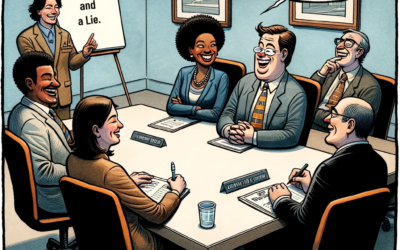How many times a year do you hear a story about a low-performing person who cannot be switched or removed from your department (or from the organization) because the paperwork hasn’t been done? Or because obligatory conversations have yet to take place? Or because what that person has done might not qualify as a fire-able offense? If this story sounds familiar, you (as leader of your department or organization) need to serve notice—not to the low-performing person, but to HR!
Too often, HR takes a “check the box” approach. With this approach, people are reduced to a series of checkmarks. As a result, firings of low-performing employees may be delayed or thwarted because some box hasn’t been checked yet or there isn’t really a suitable box to describe the problems these employees present.
With a “check the box” approach, HR departments start to see people as objects, not people. And that attitude is communicated to and frequently adopted by operating managers. Pretty soon discussions revolve around boxes to be checked rather than the people themselves. The “human” in Human Resources goes missing.
If we treat employees as people, not as a collection of checkmarks (about tasks completed or skills demonstrated), we can talk about them holistically. We can see them as part of a living system. And we can better appreciate how some team members participate and share among colleagues, add synergy to the system, and multiply the outcomes that the system is established to create—while others, sadly, diminish the performance of the whole.
Asking an employee simply if they accomplished a task (yes or no) or if they fulfilled the role set out by the job description seems fair and equitable. But this approach often misses key intangibles—both positive contributions and negative side effects.
Sometimes a person can do everything the job requires and yet how they interact and show up has a debilitating effect on the team. It may have been hard to pinpoint the exact reason, but you’ve likely had such a person who you knew was dragging the team down. In these instances, HR shouldn’t just show you the checked boxes that make firing impossible. Their hands aren’t tied, at least not in a right-to-work state like Minnesota.
A friend of mine shared with me an experience of a team that was doing equine team work. The team was asked to go into the ring and get a horse to move around the outside of the group in a clockwise direction. The team formed a circle quickly, and the horse reacted to their intention. I don’t understand how and why that happens exactly, but the horse began to walk around the team in a clockwise direction—until it got to this one team member where it just stopped. The horse would not move and was described to me as confused. When the team met to discuss what had happened, they all said this is exactly what happens at work with this team member. Things just stop at this team member and pile up and become chaotic.
As a leader, you only have two choices when it comes to a low-performing team member: train or fire. It is not complicated. And there are only three questions you need to ask yourself (and, contrary to “check the box” HR people, none of the questions is “Did you document every move?”) The three questions are:
- Is the employee capable of doing the work?
- Is the employee motivated to change?
- Do you have the time and resources to develop them?
If you answer anyone of these “No,” the answer is fire! It is not “Wait six months so that they can go through HR’s box-checking process.” Treat people as people, give them clear expectations, and hold them to them. Don’t assume that working for you is the best thing in the world when it may not be for them. If it was, they would likely be showing up differently.
We once had an employee who was penning swastikas on his cubicle. Our company policy stated clearly that employees could not promote their religion or political philosophies at work. So at the end of the shift, the employee sat down with one of our two Jewish owners. The discussion started with a question: Did the employee understand that they work for a firm owned by two Jewish people? Then, did he understand our policy? And that damaging the office furniture was not appreciated? He finished the day at work and then never showed up again. We didn’t have to fire him, but we would have if he wasn’t motivated to change.
Fear of lawsuits is often cited by HR departments as a reason not to terminate employees. Lawsuits are a legitimate concern, but business leaders should also fear the collateral damage and costs that low-performing employees incur. Once people are flagged as low-performers or bad fits, very rarely do they reverse course. It’s often better to pay them to leave than it is pay them to stay and drag others down.
HR sometimes fight to keep people in their jobs partly because of the key performance indicators that HR people themselves are measured by—turnover rate, mis-hires, employment comp levels. These are certainly important metrics, but not at the expense of the synergistic lift of the right team working together. Getting the wrong person off the bus is as important—and sometimes more important—than getting the right one on.
If your HR department is not getting the wrong people off or not quickly enough, give them notice! HR departments shouldn’t be a combative or obstructionist presence. They should help leaders form and maintain strong, cohesive, and high-performing teams.




